 klaus-michael schneider
klaus-michael schneider
Keywords: education |
Links: FOTW homepage | search | disclaimer and copyright | write us | mirrors

Last modified: 2021-08-26 by  klaus-michael schneider
klaus-michael schneider
Keywords: education |
Links: FOTW homepage |
search |
disclaimer and copyright |
write us |
mirrors
See also:
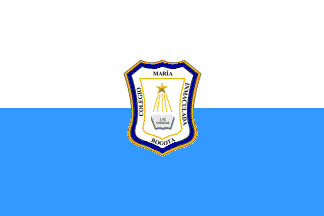 image by Ivan Sache, 11 January 2009
image by Ivan Sache, 11 January 2009
"Colegio María Inmaculada" was founded in 1906 in
Bogotá, as "Sagrada Familia" (Holy Family) by the
Community of the Tertiary Capuchin Sisters, a community founded
by Friar Luis Amigó on 4 April 1905 in Riohacha, Department of
Guajira.
The flag of the institute can be seen on the stage on photos
taken during the celebration of the Family Day 2007.
The flag, as shown graphically and described on the website of
the institute, is horizontally divided white-light blue with the
emblem of the institute in the middle.
The emblem of the institute shows a yellow star sending four
yellow rays to an open book charged with the words "LUZ /
CIENCIA" (Light / Science).
Ivan Sache, 11 January 2009
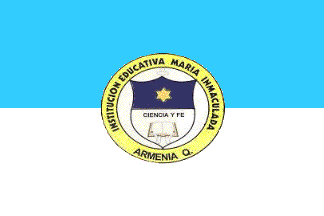 image by Ivan Sache, 03 July 2011
image by Ivan Sache, 03 July 2011
"Institución Educativa María Inmaculada" was founded on 11 February 1963 in
Armenia (Quindío Department) by the Sisters of the Poor of St. Peter Claver
(Hermanitas de Los Pobres de San Pedro Claver), a congregation founded on 11
February 1912 by Mother Marcelina (Luisa Marcelina Aveledo Aveledo, 1874-1959).
The flag of the institute is presented on the institute's website as
horizontally divided light blue-white with the institute's emblem in the middle.
The colors represent protection and help granted by the Virgin to all the
members of the educational community.
The emblem of the institute is made of a shield placed on a white disk
surrounded with a yellow ring inscribed with "INSTITUCION EDUCATIVA MARIA
INMACULADA / ARMENIA Q." The shield, of Swiss shape and horizontally divided
blue-white, is surmonted by a cross trefoiled symbolizing redemption. The blue
part, of the color of the Virgin's cloak, recall the Marian virtues - high
dignity, majesty, beauty, commitment and abnegation - to be maintained by all
students. A seven-pointed golden star placed in the middle of the blue field
represent faith that should guide our life. The white part representing purity
and innocence, is charged with an open book supported by two hands, symbolizing
the commitment of students to science, research and culture for the development
of their human, moral, social, physical, ethical and religious potential.
Source:
http://www.colmariainmaculada.com/simbolos.html
Ivan Sache, 03 July 2011
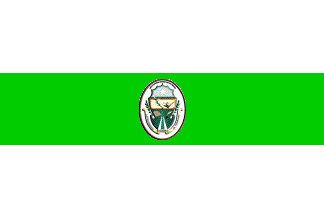 image by Ivan Sache, 5 March 2017
image by Ivan Sache, 5 March 2017
Institución Educativa de María originates in the Colegio de María,
established on 6 February 1906 by Dr. Pedro Pablo Betancourt Villegas in Yaruma,
Antioquia Department. The first kindergarten in Colombia was organized in the
school in 1911, with teaching based on the Froebel and Montessori methods. For
its 50th anniversary, the school was awarded the Silver Cross of the Boyacá
Order by Decree No. 2,986, adopted on 17 November 1955.
Institución
Educativa de María was established by Resolution No. 1,460, adopted on 20
February 2003, as the merger of Escuela Pedro Pablo Betancourt, Escuela Rosenda
Torres, Escuela Inmaculada, Escuela Santa Matilde, and Colegio de María.
http://colmaria.edu.co - Institute's
website
The flag of the institute, inaugurated on 21 September 1927, is
horizontally divided white-green-white in the center of the green
stripe.
White is a symbol of purity, joy, respect and obedience. Green is a symbol of
structured aspiration to excellence.
http://colmaria.edu.co/institucion/institucion/simbolos.html - Institute's
website
The flag in actual use is with the institute's emblem added in
the center of the green stripe.
https://www.facebook.com/Instituci%c3%b3n-Educativa - Photos, Institute's
Facebook account
The emblem is made of a shield placed on a white
background framed by a golden yellow oval ring. The shield is horizontally
divided into three fields: on top, celestial blue with a white star, symbolizing
the town of Yarumal, known as Northern Star; in the middle, yellow with
white-flowered plant and an oil lamp, a traditional symbol of knowledge, in
base, green with an open book and an inkpot and quill, other traditional symbols
of education. The shield is surrounded by two branches of laurel, a symbol of
achievement. Beneath the shield, a green parchment charged with two ascending
white stripes, which could symbolize the way to excellence. The shield is
surmounted by the institute's name, written in black capital letters forming an
arch fitted to the upper part of the framing read. Beneath the shield a white
scroll inscribed with "LA FRATERNIDAD ALEGRA EL TRABAJO" (Fraternity Makes Work
Joyous).
http://colmaria.edu.co/institucion/institucion/simbolos.html - Institute's
website
Ivan Sache, 5 March 2017
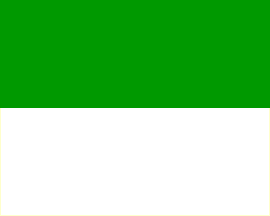 image by Ivan Sache, 17 September 2014
image by Ivan Sache, 17 September 2014
Institución Educativa Escuela Normal Superior de María is located in the
Santa Anna borough, part of the municipality of Rionegro (Antioquia Department).
The flag of the institute is in dimensions 2 m x 2.50 m, horizontally divided
forest green-white. The upper stripe represents fertility, hope, youth, and
growth. The lower stripe represents truth, honesty, peace, creativity, and
purity.
Source:
http://www.ensdemaria.edu.co/index2.php?id=10919&idmenutipo=1772&tag= -
Institute's website
Ivan Sache, 17 September 2014
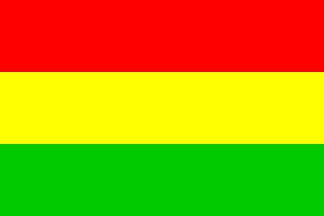 image by Ivan Sache, 04 October 2014
image by Ivan Sache, 04 October 2014
Institución Educativa María Jesús Mejía was established in Itagüí (Antioquia
Department) by Resolution No. 16,072 of 25 November 2002, as the merger of Liceo
Departamental María Jesús Mejía (est. by Decree No. 25 of 13 January 1983) and
of Escuela Matilde Arango.
The flag of the institute is horizontally divided red-yellow-green. The flag
might have been derived form the flag of Itagüí, which is horizontally divided
yellow-green-red.
Source:
http://www.iemariajesusmejia.master2000.net/index2.php?id=16269&idmenutipo=1380&tag=col
- Institute's website
Ivan Sache, 04 October 2014
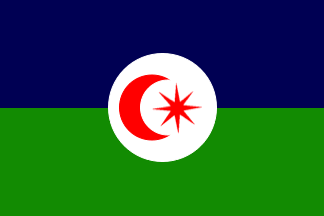 image by Ivan Sache, 6 October 2018
image by Ivan Sache, 6 October 2018
Institución Educativa Metropolitano María Occidente is located in Popayan
(Cauca department).
The flag of IEM María Occidente is divided into two
horizontal stripes of equal width, blue and green.
Blue, the cosmic color,
represents the spiritual values acquired through student's experience and
preparation.
Green, the terrestrial color, represents the student's
aspiration to progress, ecological spirit, and projection to the educational
community.
The flag is charged with a symbolic logotype, made of a universal
circle charged left with the moon and right with the sun, which represent the
institute's work schedule. The logotype also represents knowledge, science and
art.
White represents peace while red represents commitment to practical and
academic work and personal sacrifice required to progress.
http://reciclajemetropolitano.blogspot.com/2011/07/v-behaviorurldefaultvmlo.html
Blog Verde
Ivan Sache, 6 October 2018
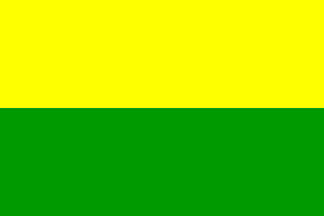 image by Ivan Sache, 27 October 2014
image by Ivan Sache, 27 October 2014
Escuela Normal Superior Indígena was established by Resolution No. 787 of 8
November 1999 in Mitú (Vaupés Department), as the latest successor of Internado
María Reina, a boarding school established by Decree No. 2,499 of 5 December
1953.
The flag of the institute is prescribed in the Institutional Education Project,
as horizontally divided yellow-green.
Source:
http://intellectum.unisabana.edu.co:8080/jspui/bitstream/10818/7586/1/123992.pdf
Ivan Sache, 27 October 2014
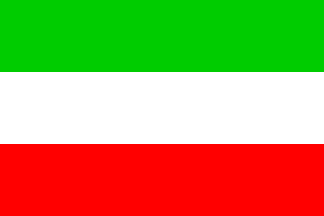 image by Ivan Sache, 30 October 2014
image by Ivan Sache, 30 October 2014
Escuela Normal Superior de Señoritas Mariano Ospina Rodríguez was established
on 31 August 1956 in Fredonia (Antioquia Department) by Margarita Correa de
Escobar. Escuela Normal Superior Mariano Ospina Rodríguez was eventually
established by Departmental Resolution No. 1,816 of 30 September 1998. The
institute is named for the statesman Mariano Ospina Rodríguez (1805-1885;
President of Colombia, 1857-1861), who pushed the Bill that established Normal
schools in Colombia and ran Colegio Académico (today Universidad de Antioquia),
as well as rural boarding school established in 1852 in Fredonia on the slopes
of Combia (today, Hacienda El Colegio).
The flag of the institute, inaugurated in 1958 on Corpus Christi Day, is
horizontally divided green-white-red. Green is a symbol of the agricultural
production and resources of the municipality of Fredonia. White is a symbol of
the clouds and snow that cover Combia, Fredonia's emblematic mountain. Red is a
symbol of fully ripe coffee berry, of blood growing from the earth, and of
coffee production.
Source:
http://www.ensumor.edu.co/bandera.html - Institute's website
Ivan Sache, 30 October 2014
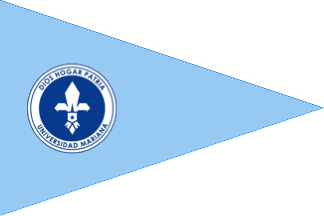 image by Ivan Sache, 10 January 2021
image by Ivan Sache, 10 January 2021
University Mariana, located in Pasto (Nariño), is composed of the Faculties
of Education; Humanities and Social Sciences; Health Sciences; Accounting,
Economic and Administrative Sciences; Engineering.
The university is managed
by the Community of the Franciscan Sisters of Mary Immaculate, a congregation
established on 31 March 1893 in Túquerres by Mother Caridad of the Holy Spirit
(Maria Josefa Karolina Brader, 1860-1943) and approved on 16 May 1933 by the
Holy See. Pasto is the seat of Nuestra Señora de la Merced, one of the six
provinces composing the congregation.
Instituto Mariano was established
by Decree No. 31,784 issued on 3 May 1967 by the Ministry of National Education.
The school was inaugurated on 10 October 1967 by Alberto Giraldo Restrepo
(1918-1976), Bishop of Pasto (1961-1976), and José María Salazar Bucheli
(1930-2020), Governor of Nariño (1964-1968). Affiliated on 26 February 1970 to
Pontificia Universidad Javeriana, the institute was granted full university
status and renamed to Universidad Mariana by Resolution No. 1,362 issued on 3
February 1983.
http://www.umariana.edu.co
Institute website
The symbols of Universidad Mariana are prescribed by Agreement No. 30 issued on
26 September 2016.
The original design of the flag, of unknown author,
has been changed: the word "PASTO", placed along the hoist, from top to bottom,
in the left corner, has been suppressed.
The flag is composed of a white,
horizontal rectangle charged with a celestial blue isosceles triangle with the
base placed along the hoist and the opposed point reaching the flag's fly. In
the center is placed the coat of arms of Universidad Mariana, in diameter 1/3 of
the flag's hoist.
Blue and white are the colors of Mary Immaculate, the
university's patron.
White is a symbol of purity and peace Purity of the
body, of the soul, of thought and acts, imitating Mary, the perfect woman and
mother. Peace is a commitment for all, the university campus being a peace
laboratory where respect for difference reigns.
Blue is a symbol of serenity
and an invitation to a safe coexistence that build and strengthen the
institutional identity.
The coat of arms is of unknown origin. There is
no documentation on its design and legal background. According to Mother
Elisabeth Guerrero Navarrete, rector of Universidad Mariana from 1979 to 1987,
the symbol, of unknown designer, was adopted in 1968.
The original design,
used by Instituto Mariano only on official documents, was hardly changed. The
shade pf the blue color, the location and name of the institute were not
prescribed by any official norm.
One of the earliest versions had the writing
"UNIVERSIDAD MARIANA" scattered between the circle's upper and lower parts. The
most recent version features a background of the institutional blue color, with
the motto "DIOS, HOGAR, PATRIA" (God, Home, Motherland) in the upper part and
the name "UNIVERSIDAD MARIANA" in the lower part.
The present-day's coat
of arms is composed of two concentric circumferences forming the outer border.
The space between them is approximately twice their width. Centered, a circle
contains a fleur-de-lis and a five-pointed star. Between the circle and the
outer circumferences are shown the words "DIO, HOGAR, PATRIA" in the upper part,
and "UNIVERSIDAD MARIANA" in the lower part, the two in capital letters.
As
stated in the Chronicle of Instituto Mariano (1964-1972, p. 19), the
fleur-de-lis or lily is a symbol of a generous soul offering reward.
The star
is a symbol of felicity, meaning greatness, truth, light, majesty and peace,
being as well a symbol of prudence.
http://www.umariana.edu.co/simbolos-umariana.html
University website
Photo
https://userscontent2.emaze.com/images/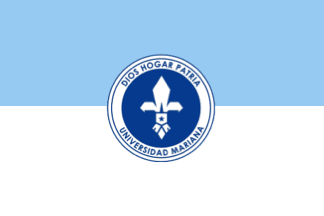 image by Ivan Sache, 10 January 2021
image by Ivan Sache, 10 January 2021
The flag is also used as
horizontally divided celestial blue-white with the university's emblem in the
center.
Photos
https://www.umariana.com.co/noticias/index.php/623-se-llevo-a-cabo-la-jornada-de-bienvenida-a-estudiantes-de-primer-semestre
https://www.umariana.com.co/noticias/index.php/607-docente-investigadora-del-programa-de-trabajo-social-participa-en-proceso-de-formacion-internacional
Ivan Sache, 10 January 2021
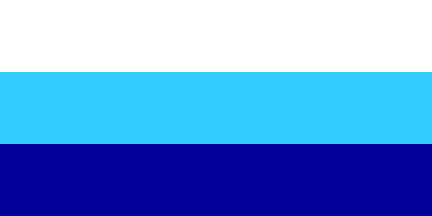 image by Ivan Sache, 16 November 2014
image by Ivan Sache, 16 November 2014
Institución Educativa Técnica Industrial Maricé Sinisterra was established in
1972 in Cali (Valle Department) by the Motovalle corporation [est. in 1955, one
of the main corporations of the Colombian automobile industry], under the name
of Escuela Motovalle. The school was subsequently renamed Escuela Maricé
Sinisterra, as a tribute to the teacher Maricé Sinisterra, who had been murdered
during a community meeting.
Escuela Maricé Sinisterra and Escuela La Solidaridad were merged by Decree No.
939 of 29 May 1991 to form Escuela San Juan de Dios. Unidad Docente Maricé
Sinisterra was established in 1998; Institución Educativa Técnica Industrial
Maricé Sinisterra was eventually established by Decree No. 1,722 of 3 September
2002.
The flag of the institute is horizontally divided white-light blue-dark blue.
The flag represents the three-staged learning process. White is a symbol of
purity, clear mind, and the apex of the learning process. Light blue is a symbol
of the second stage of evolution in the learning process. Dark blue is the
symbol of initial stage of the learning process.
Source:
http://i-e-maricesinisterra.blogspot.fr/2012/10/escudo-bandera-simbolos.html
- Institute's website
Ivan Sache, 16 November 2014
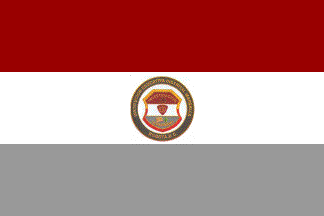 image by Ivan Sache, 26 July 2014
image by Ivan Sache, 26 July 2014
Institución Educativa Distrital Marsella was established in 1967 in the
Marsella borough (Bogotá). Concentración Marsella was inaugurated on 26 July
1970 and renamed Centro Distrital Marsella in 1992.
The flag of the institute, adopted in 1998, is horizontally wine red-white-gray
with the institute's emblem in the middle. Wine red (purple) is a symbol of
serenity and interior peace. White is a symbol of peace, faith, and
spirituality. Gray is a symbol of inspiration, creativity, and input.
Source:
http://www.redacademica.edu.co/webcolegios/08/marsella/simbolos.html -
Institute's website
Ivan Sache, 26 July 2014
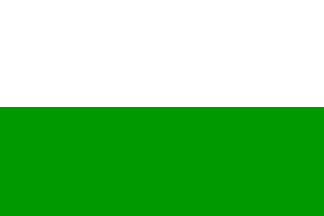 image by Ivan Sache, 17 November 2014
image by Ivan Sache, 17 November 2014
Institución Educativa Técnica Martin Pomala is located in Ataco (Tolima
Department). The institute is named for Martin Pomala (1884-1951), one of the
most popular poets in Tolima ("Sangre y otros poemas", 1941). He was murdered
while earning his life as a school policeman.
The flag of the institute is horizontally divided white-green. The colours are
those of the flag of Ataco. White is a symbol of peace, while green is a symbol
of the natural resources and of hope.
Source:
http://ietmartinpomala.blogspot.fr/2011/11/simbolos-institucionales.html
Ivan Sache, 17 November 2014
 image by Ivan Sache, 15 October 2018
image by Ivan Sache, 15 October 2018
Escuela Maternal y Jardin Infantil Pasitos (Small Steps Maternal School and
Kindergarten) is located in Cúcuta (Norte de Santander Department).
The
flag of Escuela Maternal y Jardin Infantil Pasitos is horizontally divided
blue-white.
http://sites.aiyellow.com/jardininfantilpasitos/nuestro_jardin.html
School website
Ivan Sache, 15 October 2018
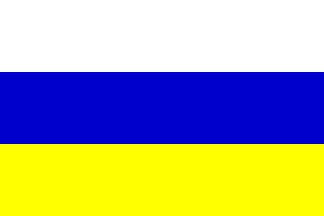 image by Ivan Sache, 09 July 2011
image by Ivan Sache, 09 July 2011
"Colegio Maximiliano Kolbe" was founded on 1 February 1989 in Bogotá by Pedro
M. Sanabria Ortiz and Reynelda Becerra de Sanabria. The institute is named for
the Polish Franciscan Friar Maximilan Kolbe (1894-1941, canonized on 10 October
1982 by Pope John Paul II), who volunteered to die in place of a stranger in the
Nazi German concentration camp of Auschwitz.
The flag of the institute is shown graphically on the institute's website as
horizontally divided white-blue-yellow. White represents spirituality based on a
Christian vision of the world. King blue represents reality, achievement and
success, recalling that excellence is built and transmitted with science, rigor
and information. Yellow represents wealth, skills and values.
Source:
http://www.maximilianokolbe.edu.co/simbolos.html
Ivan Sache, 09 July 2011
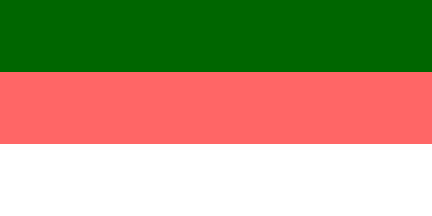 image by Ivan Sache, 28 November 2014
image by Ivan Sache, 28 November 2014
Institución Educativa Técnica Empresarial Maximiliano Netra Lamus was
established by Municipal Agreement no. 41 of 6 August 1998 in the
borough of Protecho (Municipality of Ibagué, Tolima Department),
succeeding Institución Educativa Protecho B, which had been
established on 19 January 1998.
The flag of the institute is horizontally divided green-pink-white.
Source:
http://maximilianoneiral.edu.co/index.php/institucional/simbolos - Institute's website
Ivan Sache, 28 November 2014